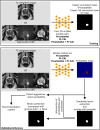Effective reduction of unnecessary biopsies through a deep-learning-assisted aggressive prostate cancer detector
- PMID: 40307379
- PMCID: PMC12043811
- DOI: 10.1038/s41598-025-99795-y
Effective reduction of unnecessary biopsies through a deep-learning-assisted aggressive prostate cancer detector
Abstract
Despite being one of the most prevalent cancers, prostate cancer (PCa) shows a significantly high survival rate, provided there is timely detection and treatment. Currently, several screening and diagnostic tests are required to be carried out in order to detect PCa. These tests are often invasive, requiring either a biopsy (Gleason score and ISUP) or blood tests (PSA). Computational methods have been shown to help this process, using multiparametric MRI (mpMRI) data to detect PCa, effectively providing value during the diagnosis and monitoring stages. While delineating lesions requires a high degree of experience and expertise from the radiologists, being subject to a high degree of inter-observer variability, often leading to inconsistent readings, these computational models can leverage the information from mpMRI to locate the lesions with a high degree of certainty. By considering as positive samples only those that have an ISUP≥2 we can train aggressive index lesion detection models. The main advantage of this approach is that, by focusing only on aggressive disease, the output of such a model can also be seen as an indication for biopsy, effectively reducing unnecessary biopsy screenings. In this work, we utilize both the highly heterogeneous ProstateNet dataset, and the PI-CAI dataset, to develop accurate aggressive disease detection models.
© 2025. The Author(s).
Figures






References
-
- Siegel, R. L., Miller, K. D., Fuchs, H. E. & Jemal, A. Cancer statistics, 2022. CA Cancer J. Clin.72, 7–33 (2022). - PubMed
MeSH terms
Substances
Grants and funding
- UIDB/00408/2020 (https://doi.org/10.54499/UIDB/00408/2020)/Fundação para a Ciência e a Tecnologia
- UIDP/00408/2020 (https://doi.org/10.54499/UIDP/00408/2020)/Fundação para a Ciência e a Tecnologia
- 10.54499/2021.05322.BD (https://doi.org/10.54499/2021.05322.BD)/Fundação para a Ciência e a Tecnologia
- IMS UIDB/04152/2020 (https://doi.org/10.54499/UIDB/04152/2020)/Fundação para a Ciência e a Tecnologia
- 952159/Horizon 2020
LinkOut - more resources
Full Text Sources
Medical
Research Materials
Miscellaneous

